In today’s world, the emphasis on labels and social status through clothing is undeniable. Yet, amidst this obsession, there’s a dedicated community preserving Renaissance fashion—a period celebrated for its groundbreaking style.
Renaissance queen attire symbolized a departure from convention, embracing individual expression inspired by art and literature. Vibrant colors and luxurious fabrics defined this era, fueled by the era’s expanding trade and travel routes, which facilitated the spread of fashion trends across Europe.
The legacy of Renaissance fashion endures as a catalyst for self-expression and innovation, shaping the modern fashion landscape. Clothing became a canvas for conveying status, wealth, and personal taste.
Women’s clothing in the renaissance, in particular, reflected social standing. The upper class women wore opulent fabrics like velvet and silk, while peasant women favored more practical materials such as wool and linen.
The era’s sumptuary laws further dictated clothing choices, regulating extravagance and delineating social classes through fabric types, colors, and embellishments.
Curious about Renaissance fashion? Explore women’s clothing from this historic period and discover its cultural significance. Join us on a journey through time and style!
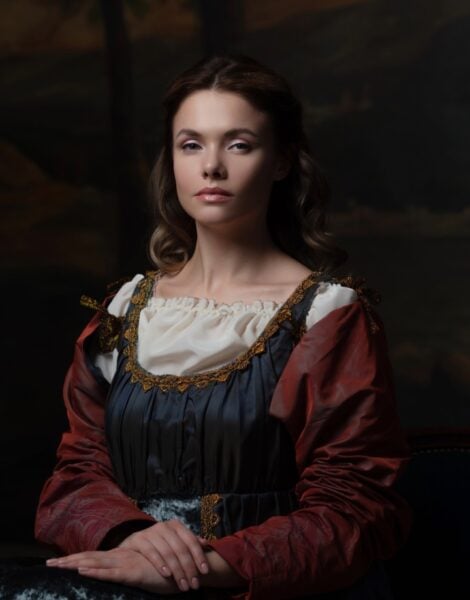
Key Takeaway
- Renaissance fashion was a significant departure from previous eras, emphasizing individualism, self-expression, and luxury, with Italy as the focal point.
- Women’s clothing during the Renaissance reflected social standing, with upper-class women wearing opulent fabrics like velvet and silk, while peasant women favored more practical materials such as wool and linen.
- Dressing like a Renaissance queen involves incorporating key elements such as luxurious fabrics, ornate details, rich colors, and subtle embroidery, while also considering modern comfort and personal style.
- The influence of Renaissance fashion persists in modern times, with designers still valuing high-quality materials, traditional techniques, and the era’s emphasis on craftsmanship and self-expression.
What Defined Renaissance Fashion?
Renaissance fashion departed from the past, with Italy as the focal point. It focused on self-expression and individualism, and these traits made other countries follow the trend. Although it persisted briefly, it left a significant mark on fashion.
Key features included:
- Personal Style: Unlike the Middle Ages, where clothing reflected social status, Renaissance fashion allowed for personal expression.
- Fitted Clothes: Both men and women wore fitted garments to highlight their physique.
- Luxurious Fabrics: Wealth and social class were showcased through lavish fabrics like velvet and silk, adorned with jewels, embroidery, and trimmings.
Dressing Like a Renaissance Queen: A Detailed Guide
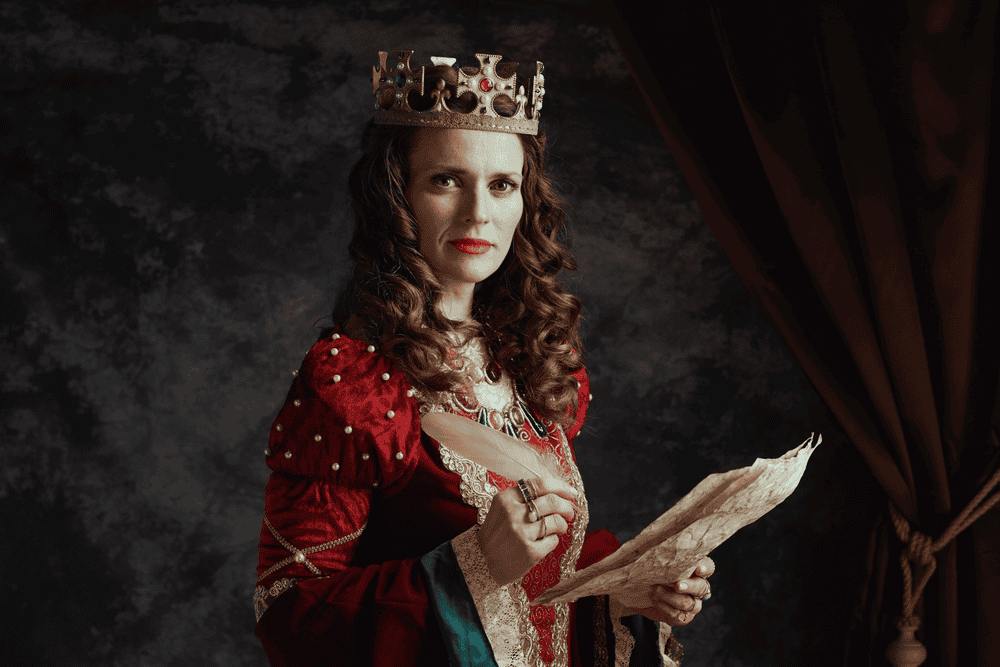
Want your fashion to speak of a certain social class while embracing individualism? Dressing like a Renaissance woman is the way to go. It is a chance to attract an audience with elegant and exquisite attire. Here is a detailed guide on how you can create this look:
Dresses and Outer Garments
Renaissance Dresses
The Renaissance dress was an intricate historical clothing, particularly for women, boasting a meticulous structure and design. This garment typically began with a linen shift as a base layer, occasionally complemented by a kirtle for additional support.
The hallmark of Renaissance dresses was their two-piece construction, featuring a separate bodice and skirt, which allowed versatility and customization. Bodices were crafted to accentuate the wearer’s figure, often incorporating boning or stuffing for an hourglass silhouette.
Luxurious fabrics such as silk and velvet were favored. These were adorned with elaborate embellishments like embroidery and jewels, reflecting the wearer’s social status and wealth.
Regional differences and social standing influenced variations in the Renaissance dress styles, with simpler designs for working-class women and more opulent creations for the nobility.
Popular features included a flowing, high-waisted silhouette with voluminous skirts, typically made of rich fabrics in regal colors.
Bodices were often separated from the skirt, enabling the purchase of different pieces to mix and match. Neckline options varied, ranging from square to V-neck and high-ruffed collars, catering to individual preferences.
Sleeve details were another focal point, with puffed sleeves featuring gathers and dramatic slashes to add romance and grandeur to the attire.
Some designers made gowns adorned with trains for formal occasions, enhancing their majestic and theatrical appeal for those wearing Renaissance dresses.
Court Dresses
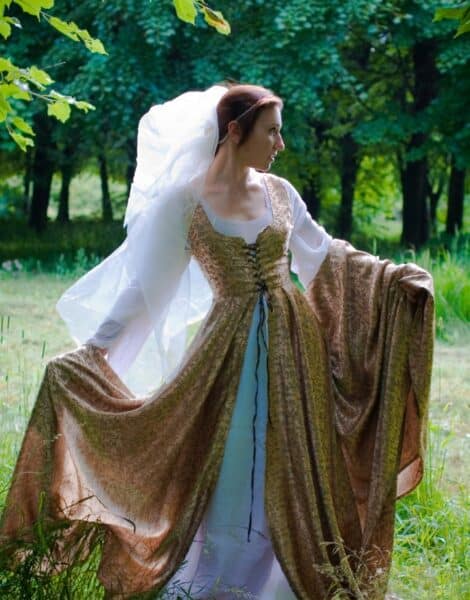
Court dresses in the Renaissance era were not just garments; they held significant power, allowing wearers to navigate the intricate social and political landscape of the court.
These dresses were statements of wealth, social standing, and personal taste.
In a society deeply entrenched in hierarchy, clothing became a tool for communication, with expensive fabrics, intricate details, and stunning jewels signifying high social status and family wealth.
Court life was competitive, and women used their attire to outshine one another, showcasing their elegant tastes and craftsmanship.
Beyond mere fashion, court dresses played crucial roles in political and diplomatic settings. They were used to symbolize support for specific individuals or factions, with colors, fabrics, and symbols holding hidden meanings understood by select groups within the court.
As international relations expanded, court dresses also became a means of showcasing national identity, incorporating elements of national dress or specific colors into their designs.
Court dresses allowed self-expression, with women selecting colors and bodices tailored to complement their complexion and showcase their figures.
These garments provided a degree of individualism in a restrictive court environment, empowering wearers to feel confident and beautiful.
Court dresses featured luxurious fabrics like silk and velvet, vibrant colors achieved through advanced dyeing techniques, metallic accents, jewels, pearls, impressive embroidery, intricate trimmings, structured bodices, and grand trains, all contributing to their visually stunning and unique nature.
While slight variations existed based on personal preferences and regional styles, all court dresses shared a focus on luxury, intricate design, and formal silhouettes, setting them apart from everyday wear.
Italian Gowns
The Italian Renaissance fashion era marked a significant shift towards luxury, individualism, and sophistication in fashion. These gowns were characterized by:
- Long and flowing design, creating a graceful and elegant movement.
- A high waistline accentuated the torso and elongated the silhouette.
- Luxury materials like silk, velvet, and brocade signify social status and wealth.
- Vibrant colors such as deep purples, emerald greens, and regal blues.
- Two-piece construction, allowing for mix-and-match options.
- Intricate details, including fine embroidery, beads, jewels, pearls, and trimmings, showcasing wealth and taste.
While Italian gowns spearheaded the trend, variations existed based on regional influences.
For instance, Florentine gowns exuded extravagance, while Venetian styles incorporated Byzantine influences and detailed embroidery.
Materials such as silk, velvet, and brocade were favored for their luxurious feel and intricate patterns, while linen provided a comfortable base layer.
Decorations included Venetian lace, braids, fringes, ribbons, intricate embroidery with gold and silver threads, pearls, and jewels. Slashing, a popular decorative technique, involved cutting slits in the fabric to reveal contrasting colors or undergarments, adding richness to the garment.
Wedding Dresses
During the Renaissance, wedding dresses didn’t adhere to a specific style like today’s white gowns. However, certain features were common among brides’ attire:
- Color: White wasn’t the norm for wedding dresses. Brides often chose rich colors like red, blue, green, or yellow to symbolize wealth and celebration. Some regions had specific color preferences.
- Symbolism of Purity: A young bride wore a Renaissance dress with elements symbolizing purity, such as light pastel shades, floral motifs like lilies or orange blossoms, and linen or silk veils.
- Material and Decoration: Brides aimed to display their family’s wealth, opting for luxury fabrics like brocade or silk adorned with pearls, jewels, trimmings, and embroidery.
- Style: Silhouettes varied based on the trend of the time. Early Renaissance brides wore dresses with slightly raised waists and flowing sleeves, while late Renaissance brides favored fitted silhouettes with shorter puff sleeves. Dresses in the mid-16th century were more elaborate, considering comfort and movement during the celebration.
Components of a Renaissance Wedding Dress
- Fitted Kirtle: Made of wool or linen for comfort, extending to floor length or shorter.
- Bodice: Hugged the torso with a defined waist, sometimes separate or as a single piece with the skirt, fastened with laces, hooks, buttons, or eyes.
- Optional Stomacher: This garment is worn in front of the bodice. It is often triangular and decorated with jewels, embroidery, or contrasting fabrics.
- Sleeves: Early Renaissance dresses had long, flowing sleeves, which were replaced by puff sleeves in the late Renaissance, adding elegance and whimsy.
- Skirt: Could be full or flowing, fitted or not, with a long train representing formality and adding grandeur to the wedding attire.
Clothing Details and Accessories
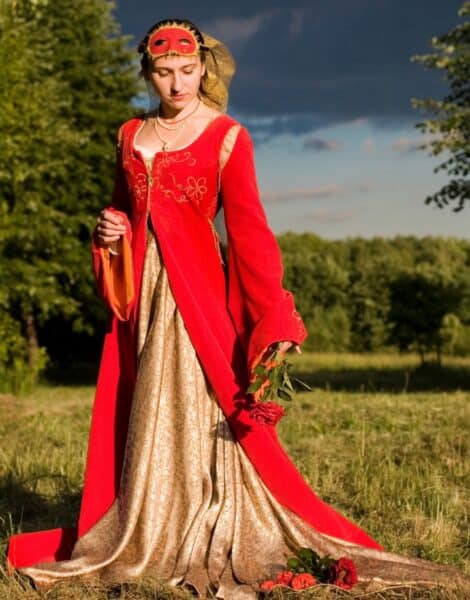
Sleeves and Collars
During the Renaissance, sleeves, and collars saw significant changes, reflecting people’s tastes and desires.
Early Renaissance
- Sleeves: In the 14th and 15th centuries, sleeves were long and flowing, often reaching the wrists or trailing on the floor. They offered an elegant drape and modest appearance. Some garments, especially men’s attire, featured fitted sleeves.
- Collars: Collars were modest and functional, with common styles including standing collars that protected wearers and V-neck collars paired with visible chemise undergarments. A high collar was also a popular choice, with low necklines dominating the era.
High Renaissance
- Sleeves: In the late 15th century and early 16th century, sleeves became more fitted and decorative. Puffy and slash sleeves for women’s gowns were popular, adding a youthful and theatrical touch.
- Collars: Collars became more ornate, featuring square shapes with intricate embroidery or lace. Artisans used starched ruffs to create frills around the neck.
Late Renaissance
- Sleeves: Sleeves became elaborate and status-oriented, featuring multiple puffs and slashes to showcase craftsmanship. Some garments had detachable sleeves for versatility.
- Collars: Ruffs became prominent, with large standing ruffs pleated and starched for dramatic effect, favored by wealthier individuals. Falling ruffs provided a more relaxed alternative to rigid styles.
Fabrics and Materials
During the Renaissance, fabrics weren’t just for making clothes; they carried deeper meanings.
They were a status symbol, with wealthy people flaunting high-quality materials like silk and velvet to show off their wealth. These luxurious fabrics were expensive and mostly available to the upper classes. Finer weaves and intricate designs were reserved for the elite.
Craftsmanship was another aspect; high-quality fabrics allowed artisans to create detailed beadwork and appliques. Plus, durable materials like silk ensured clothes lasted for generations, becoming family heirlooms.
The prominence of quality fabrics boosted trade and economies, especially in cities like Florence and Venice, leading to innovations in textile techniques. These fabrics also allowed artisans to express themselves creatively, with rich colors and textures enhancing the beauty of garments.
Gold thread and pearls were common decorations, adding elegance and symbolizing wealth and power. They were used to create intricate designs and highlight details on clothing, serving as status symbols.
For young brides, pearls symbolize innocence and purity. In the Renaissance, gold threads subtly adorned garments or formed elaborate patterns, while pearls adorned jewelry, especially in the high Renaissance, where they lavished bodices and sleeves.
By the late Renaissance, these materials were used extravagantly, with elaborate embroidery and cascading pearl arrangements becoming popular.
Accessories
During this time, women wore various popular accessories, not just for looks but also to express themselves and show their status. Let’s take a look at some common ones and what they mean:
- Jewelry like necklaces, earrings, and bracelets was often made of pearls, gold, silver, gemstones, or colored glass. It was a status symbol, with pearls especially common among noblewomen and young brides, representing purity. For example, a simple tennis bracelet is characterized by its symmetrical design of diamonds or gemstones set in a flexible band and serves as an exquisite accessory. It can enhance any outfit, adding a touch of elegance reminiscent of Renaissance opulence. Pair it with other statement pieces for a truly glamorous look. Huggie earrings, with their snug fit around the earlobe, provide a subtle yet elegant touch to any ensemble. These versatile pieces can complement both modern and Renaissance-inspired looks, adding a hint of sophistication without overwhelming the overall style.
- Brooches and pendants were used to fasten garments and display wealth or sentimental value. Elaborate brooches often had jewels or cameos and were passed down as family heirlooms. Pendants were used to hold religious relics or miniature portraits.
- Hats, veils, and hairnets were worn differently depending on marital status; married women covered their hair, while unmarried women often wore it loose or adorned it with flowers. Elaborate headpieces indicated wealth and status.
- Pins, combs, and ribbons with pearls or gemstones were used to style hair and add elegance.
Other accessories included gloves, perfume, and scented sachets. A fan was also a popular accessory.
Dressing like a Renaissance Queen Today
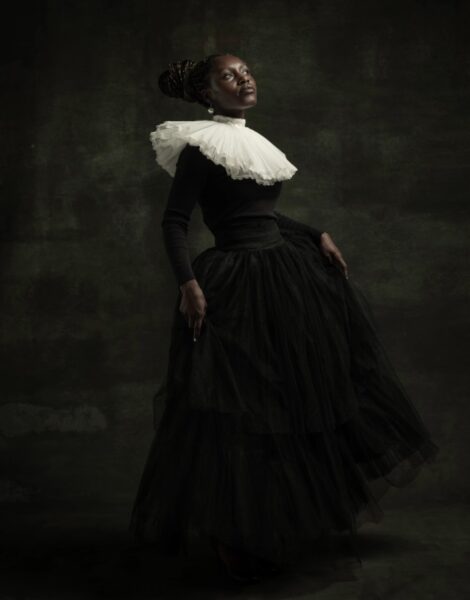
Channeling the essence of a Renaissance queen into your modern wardrobe is easier than you think. Here’s how to infuse a historical touch into your attire:
- Select Luxurious Fabrics: Incorporate silk, brocade, or velvet into your ensemble, even if it’s just a small element, to evoke the opulence of the Renaissance era. Other materials to use include wool and linen.
- Embrace Ornate Details: Opt for jewelry with antique or vintage finishes, such as gold necklaces, pearl earrings, or statement rings, to add an authentic feel to your look. Incorporate gold thread, pearls, or lace for an extra touch of Renaissance flair.
- Go for Rich Colors: Choose deep, rich hues like emerald green, sapphire blue, ruby red, or marigold and burgundy to capture the regal essence of the Renaissance.
- Seek Subtle Embroidery: Look for garments with delicate embroidery featuring floral motifs, heraldic emblems, or geometric patterns. These will add an intricate touch to your outfit.
- Incorporate Puffed Sleeves and Collared Blouses: Add a touch of high Renaissance style by opting for garments with puffed sleeves at the elbow or shoulder and collared blouses with high necks or ruffled collars.
Other Tips for Recreating Inspired Looks
- Start with Key Elements: Begin by investing in essential items from the Renaissance era, such as puffed sleeves, pleated skirts, and high collars. These pieces will give you a foundation for building your look. Remember to focus on your natural waist, as it affects the gown’s overall appearance.
- Seek Inspiration from Artwork: Explore Renaissance portraits and paintings for style inspiration, paying attention to details and color palettes. Don’t just focus on paintings; look at historical documents, fashion plates, and everyday wear depictions for a broader understanding of Renaissance fashion.
- Tailor for Modern Comfort: While aiming for historical aesthetics, prioritize your comfort by choosing well-fitted garments that flatter your figure. Opt for colors that you feel comfortable wearing. Consider modern construction techniques for comfort, such as hand stitching and boning in bodices, and consider taking a history sewing class for deeper insight.
- Mix Old with New: Combine a contemporary twist on Renaissance fashion with modern pieces. For example, pair a shirt dress with puffy sleeves for a unique and stylish interpretation of the era. You can also add high heels to complete the look.
Conclusion
The Renaissance was a time when fashion reflected social status. Upper-class people flaunted their riches through expensive fabrics, intricate designs, and lavish accessories.
Luxurious materials like silk and velvet were favored, while gold and silver threads added detail, pearls, and jewels adorned garments. This era’s influence on fashion persists today, with designers still valuing high-quality fabrics and traditional techniques like hand embroidery.
The Metropolitan Museum of Art preserves Renaissance Italy to date. Here, you can find Renaissance portraits by popular artists.
